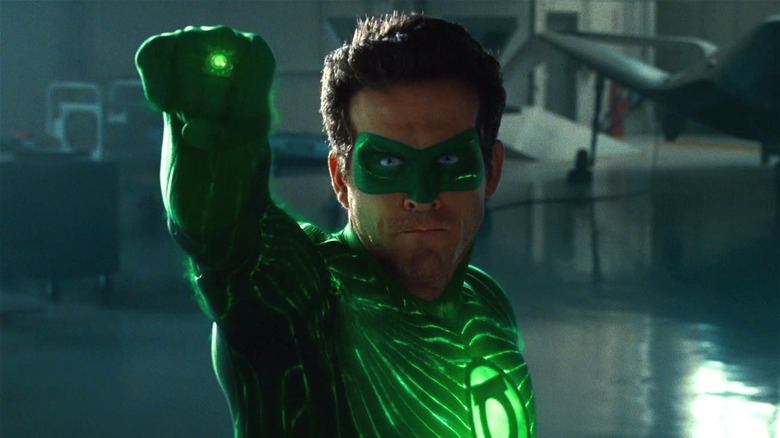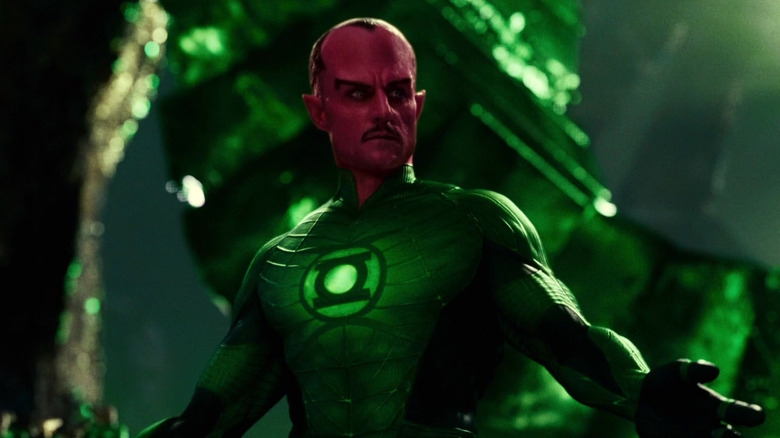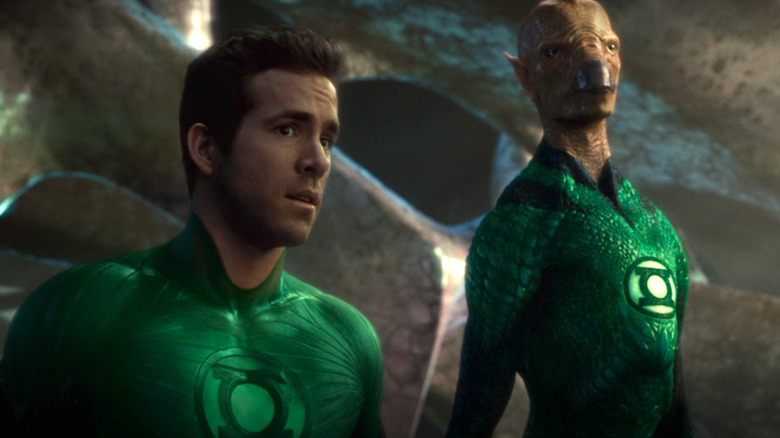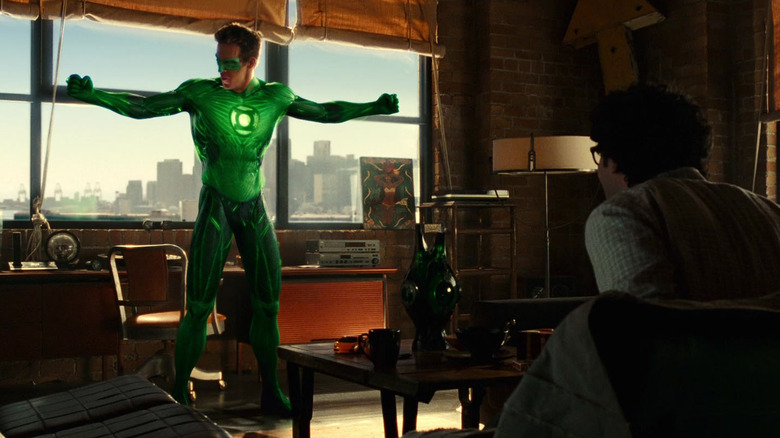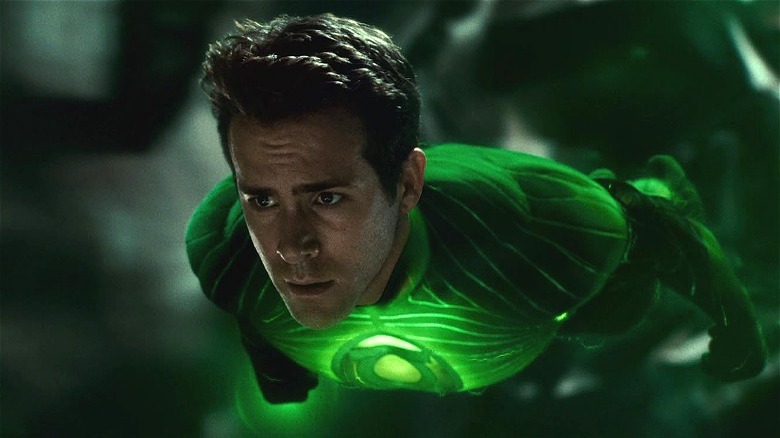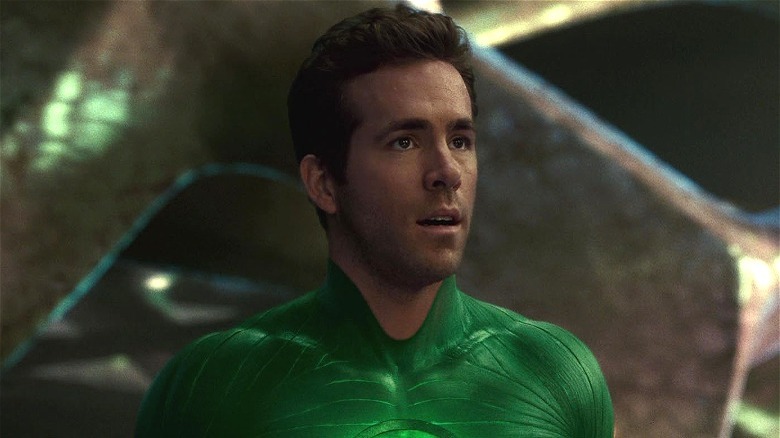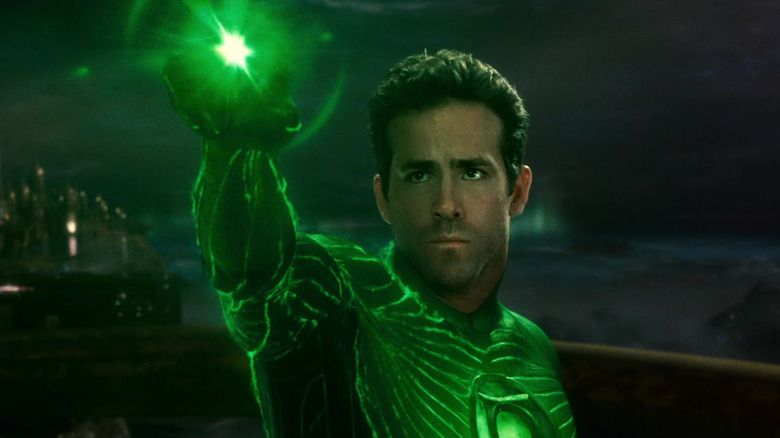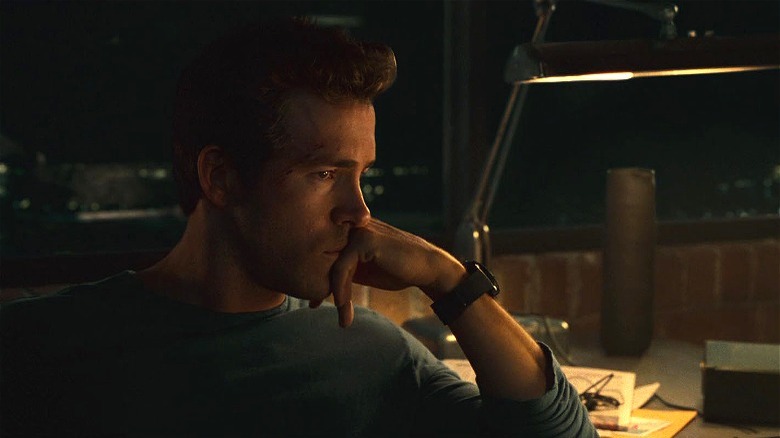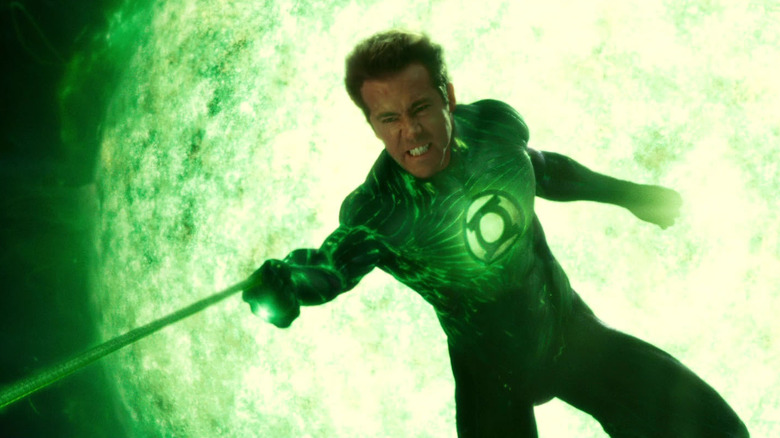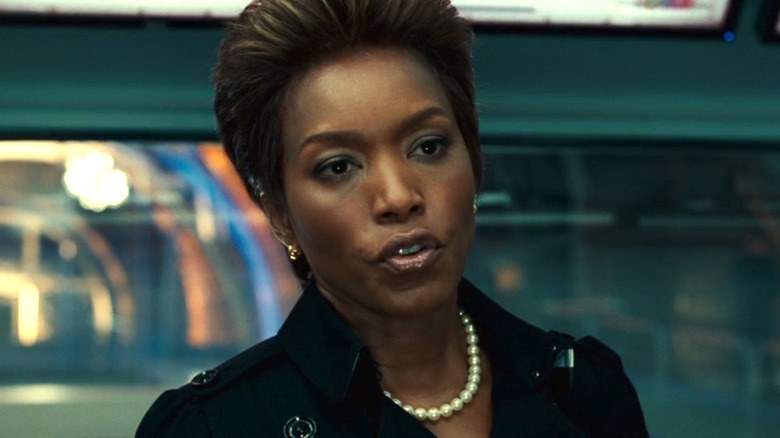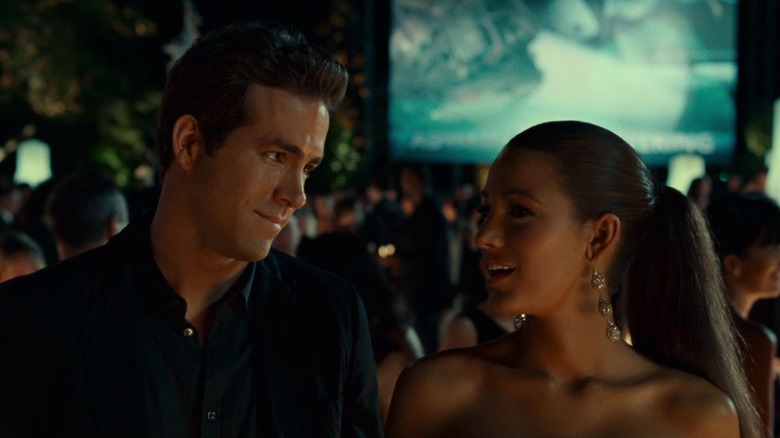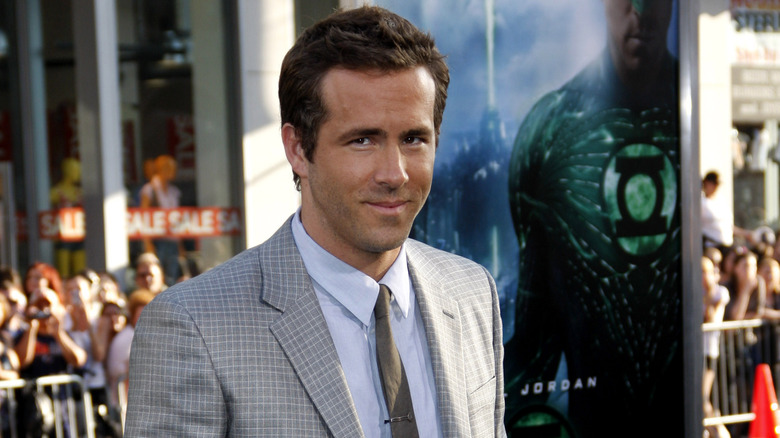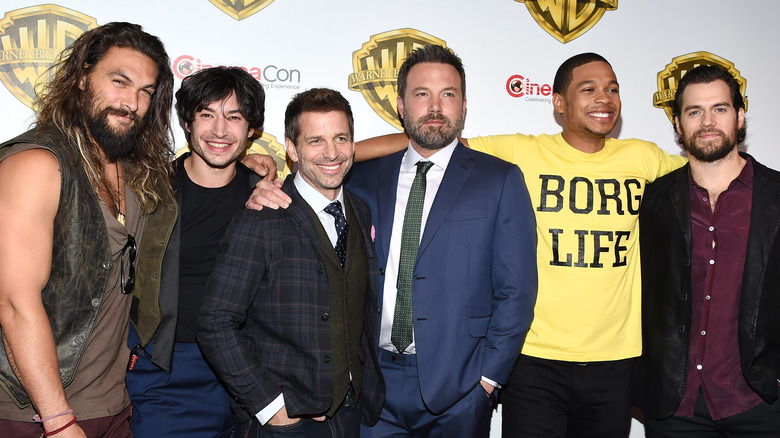Why Ryan Reynolds' Green Lantern Bombed At The Box Office
2011's "Green Lantern" was supposed to be the start of a new cinematic universe for DC superheroes, a response to the burgeoning Marvel Cinematic Universe. The film stars Ryan Reynolds as test pilot Hal Jordan, who receives the powers of an intergalactic space cop after he is bestowed with an alien ring when its original owner is killed. While struggling to prove he is worthy of its power, he must face off against the villainous Parallax, an alien entity that threatens mankind.
Debuting to much fanfare, the film was billed as an epic superhero saga unlike any other. But when it landed in theaters, it wasn't quite the incredible box office earner that the studio was hoping for. Instead of taking the world by storm, it bombed hard and was shuffled off to the wasteland of woeful superhero flops. So, what went wrong? How did the same studio that had made "The Dark Knight" just a few years earlier mess this up so badly? Here's why Ryan Reynolds' Green Lantern bombed at the box office.
The budget was way too high to turn a profit
Probably the biggest mistake that Warner Bros. made with "Green Lantern" was the sheer size of its budget. Estimated at an extraordinary $200 million, it was on par with blockbuster sequels like "Iron Man 2" and "Transformers: Revenge of the Fallen," properties that had already proven their box office potential. "Green Lantern" was a franchise starter, and it didn't feature an A-list hero like Spider-Man or Batman, so it was already facing an uphill battle. As a result of its mega-budget, "Green Lantern" needed to take in an enormous amount to be considered a hit, so it's really something of a head-scratcher that the studio invested so much money in it.
It's even more bizarre when you consider that Warner Bros. ought to have learned its lesson from 2006's "Superman Returns," which officially cost $270 million to make but actually set the studio back closer to $300 million according to some industry insiders. By contrast, Marvel's "Captain America: The First Avenger" – released the same summer as "Green Lantern" — had a more modest $140 million budget, allowing it to be a profitable hit with a $370 million box office haul. Still, the fact that "Green Lantern" topped out at just shy of $220 million worldwide means that it would have needed to keep its budget even lower to make a real profit.
Audiences weren't ready for sci-fi superheroes
Today, the idea of superheroes in space is pretty normal, but back in the early 2010s, the movie landscape for science fiction and superheroes was very different. For starters, Marvel had yet to introduce viewers to the cosmic side of the MCU, with "Guardians of the Galaxy" still a few years away. Before James Gunn put his stamp on the MCU with his brilliantly funny, action-packed film, audiences weren't really embracing science fiction action-comedies the way they do today.
When "Green Lantern" arrived in cineplexes, the biggest superhero movies were much more grounded affairs about ordinary people with extraordinary abilities. Be it "Iron Man," "The Dark Knight," or even the "X-Men" films, they all worked hard to be firmly set in a believable, Earth-based world. Even non-superhero sci-fi wasn't really going down well, with movies like "Cowboys & Aliens" and "John Carter" arriving with massive thuds. Warner Bros. and DC tried to defy the odds with a space-based, comedic action-adventure, and it just didn't take off with audiences. Perhaps if they had waited a few years they might have had more success.
DC films had no architect
Since "Iron Man" debuted in 2008 and laid the groundwork for the Marvel Cinematic Universe, much has been made about the role of Marvel Studios' president Kevin Feige, credited as the man who constructed the MCU with carefully laid plans. The problem for "Green Lantern," and DC movies in general, is that Warner Bros. had no such producer whose singular vision could serve as a steady guide.
As a result, the 2011 Ryan Reynolds film saw a series of leading producers moving in and out during development. Though Diane Nelson was president of DC Films, she wasn't the creative force that Feige was for Marvel. Greg Berlanti and Marc Guggenheim were seemingly in charge at one stage, but that didn't go as planned. Though their work on subsequent small screen hits like "Arrow" and "The Flash" has been celebrated, their contributions to the "Green Lantern" film were sometimes blamed by fans for the film's failure, despite them accounting for just half of the credited writers on the film.
In the end, the film had more than a half-dozen producers. One of them was Geoff Johns, a comic book writer who some felt should have been given the role of DC architect, but that never did come to fruition despite some brief talk in 2016.
The studio didn't know what kind of film it wanted to make
While many saw the release of "Green Lantern" as an attempt to capitalize on Marvel's MCU success, the reality is that a film about the spacefaring DC superhero had been in the works for years. The fact that the studio had already commissioned several radically different scripts seems to suggest that they had no idea what kind of film they wanted to make, which goes some way toward explaining why it was such a mess.
Back in the 1990s, Warner Bros. offered the likes of Kevin Smith and even Quentin Tarantino the chance to work on a Green Lantern film. The studio then tried to turn it into a straight-up comedy, with "Saturday Night Live" vet Robert Smigel penning a version with Jack Black in mind. Not long after that, actor Corey Reynolds — star of "The Closer" — wrote his own script that would have put him in the title role, and Warner Bros. was reportedly keen on the idea.
Eventually, all of those ideas were discarded, and Greg Berlanti and Marc Guggenheim pumped out a new script in 2010. This was later re-written, removing a possible Superman cameo. In 2023, Ryan Reynolds acknowledged that the studio really didn't have a clue. "I don't think anyone ever figured out exactly what it was," he told Entertainment Weekly, while also acknowledging the hard work of those actually making the movie.
The production suffered some setbacks
While DC and Warner Bros. had been hatching plans for a "Green Lantern" movie for over a decade, things didn't begin in earnest until Marvel blew the doors off Hollywood with "Iron Man." Though the movie was announced a year before, the production seemed to take forever and only ramped up to super-speed at the end of 2008. In February of 2009, producer Greg Berlanti — who had been considered for the directing job and had been on the project for years — was ousted in favor of Martin Campbell (the man behind the reinvention of James Bond in "Casino Royale"), with filming expected to begin in November of that year.
Unfortunately, production was soon delayed to January the following year and the release date was pushed back amid location changes. The budget later ballooned from an estimated $150 million to its eventual $200 million. Filming didn't begin until March, and when it did, it wasn't a pleasant production. In 2016, Ryan Reynolds reflected on the rushed shooting schedule and how it was a "frustrating" experience for him. He told Empire magazine (via Yahoo), "It was the classic studio story: 'We have a poster, but we don't have a script or know what we want; let's start shooting!'" It didn't get any easier from there, as the actor suffered a painful shoulder injury during filming.
The CGI is unconvincing
Let's face it: When it comes to sci-fi superhero movies, the special effects are probably the most important component. Whether it's the outer space adventure scenes, the CGI alien creatures, or just ordinary action set pieces that can't be done practically, the visual effects need to be perfect if the picture is going to be a massive hit. Unfortunately, despite its bloated budget, the computer-generated effects in "Green Lantern" are surprisingly unconvincing, particularly when it comes to the titular hero's outfit.
Much has been made over the years about how bad the CGI costume looks in "Green Lantern." Rather than have Ryan Reynolds wear an actual fabric outfit, the studio opted for VFX to paint his body, hoping to make it appear as though alien energy had created it. It looks terrible, and it's far from the only problem with the visuals. From the giant cloud that attacks the city to the energy constructs that Hal Jordan creates, most of the visual effects in the film feel cartoonish. CGI characters like Kilowag (Michael Clarke Duncan), Tomar-Re (Geoffrey Rush), and Abin-Sur (Temuera Morrison) look like they've come straight out of an animated series rather than a $200 million studio tentpole.
Ryan Reynolds wasn't right for the role
There's so much that goes into making a big superhero movie, but none of it matters if you don't have the right actor. Marvel execs hit the jackpot when they put Robert Downey Jr. in the role of Tony Stark for "Iron Man." For "Green Lantern," Warner Bros. opted for a similarly snarky and charismatic leading man in Ryan Reynolds. On paper it seemed like a great move. Unfortunately, the version of Hal Jordan he played wasn't really a match for the character fans know and love.
Far from the serious, tough-as-nails test pilot, this Hal Jordan was light-hearted and quick with a joke. While that was perfect for Ryan Reynolds, it wasn't right for "Green Lantern," and whenever the film tries to make Jordan a mix of sassy and serious, Reynolds just can't pull it off. And that's not just our opinion, because many fans have long felt that Reynolds was the wrong man to put on the green ring.
"I've always thought Reynolds was wrong for the part of Hal," said Redditor u/SlasherDarkPendulum, while u/GoldenGood04 wrote that "Hal Jordan needs to be played by an actor who can be funny, but doesn't need to be funny all the time." It turns out that Reynolds wasn't actually the first choice for the part. Marvel star Bradley Cooper auditioned for the role of Hal Jordan and was apparently the frontrunner at one stage, but Reynolds was deemed a smarter choice and the rest is history.
Martin Campbell was the wrong director
A bad choice of leading man can be in the eye of the beholder. After all, for as many detractors as Ryan Reynolds may have had, he also had plenty of fans who wanted to see him return for a sequel. But when it comes to a movie's director, it's even more important that the right person is chosen, as they will ultimately be the one to shape the story. And in the case of "Green Lantern," the studio picked the wrong person. This isn't our opinion, or even that of the fans — this comes from the director himself.
Martin Campbell spoke with Screen Rant a decade after "Green Lantern" bombed in theaters and copped to being one of the biggest reasons it failed. "The film did not work, really. That's the point, and I'm partly responsible for that," he admitted. He went on to say that he regretted ever accepting the gig, which he now concedes should have gone to someone with a genuine passion for the source material. "Superhero movies are not my cup of tea, and for that reason, I shouldn't have done it," Campbell said. "But directors always have to carry the can for the failures. What do they say? Success has many fathers, failure has one. And that's me."
Too much focus on cinematic universe building
The whole cinematic universe thing has worked wonders for Marvel, but you could argue that the studio is too concerned with the interconnectivity of its projects at times, placing too much importance on setting up future movies when the focus should be the movie at hand. Including nods to other projects is perhaps expected when you're 30-plus films into your cinematic universe, but "Green Lantern" is (or was intended to be, at least) the first entry in a DC movie universe. As such, all the set-ups feel somewhat forced.
Instead of just focusing on Hal Jordan and his epic origin story, the movie spends valuable time trying to put pieces in place for sequels and a wider cinematic universe. In the first "Iron Man," Nick Fury and SHIELD are part of a minor subplot that doesn't come to fruition until after the end credits have rolled. In "Green Lantern," there's a similar story involving Amanda Waller (Angela Bassett), the director of a shadowy government agency. It's not uninteresting, but it eats up way too much of the film and takes you out of Hal's story.
Of course, Waller's presence does relate to the story of the villain, Hector Hammond. However, it's largely unnecessary and seems to only exist to lay the groundwork for spin-offs and team-ups down the road. The subplot involving Sinestro (a devious Green Lantern that fans already know will one day become a villain) is also superfluous. The film should have concentrated on the hero's journey throughout, but the studio was too busy getting ahead of itself. In the end, this worked against Warner Bros. and DC, because it made "Green Lantern" weaker and helped kill off any notion of a sequel.
It dropped during a busy summer blockbuster season
Summer is always the best time to release a big superhero movie, so Warner Bros. wasn't wrong to pick a release date in the middle of June. The problem was, there were other, better options for blockbuster movies around that same time, which became particularly problematic when early reviews for "Green Lantern" weren't good. Fox's "X-Men: First Class" was still in theaters, having dropped just a couple of weeks earlier, and this gave an alternative to viewers seeking some superhero adventures. It was part of an already established film franchise and contained some familiar characters, so it was a safer bet for your average movie-goer.
Perhaps the biggest blow for "Green Lantern" came in the shape of "Transformers: Dark of the Moon," which arrived in cineplexes within two weeks of the DC film's debut. Then, "Captain America: The First Avenger" — heavily promoted as part of the same universe as the smash hit "Iron Man" — landed a month later, and was much better reviewed from just about every conceivable angle. Any chance that "Green Lantern" had of making a profit was dashed. All three films out-performed the Ryan Reynolds vehicle, the only one of the bunch not to earn a follow-up.
Why Ryan Reynolds thinks Green Lantern failed
Ryan Reynolds hasn't been shy about the failure of "Green Lantern." He's a huge star thanks largely to playing the title role in the "Deadpool" films, which have poked fun at the famous flop — in a "Deadpool 2" post-credits scene, Deadpool travels back in time and stops "Green Lantern" from ever being made by shooting Reynolds as he's reading the script. Reynolds can look back and laugh, but it wasn't so easy when the movie had nearly destroyed his career. "I represented the death of the superhero for a while," he told Variety in 2016. "After 'Green Lantern,' I was pretty much unhirable."
As for what went wrong, Reynolds has discussed at length why he feels "Green Lantern" failed, from its overinflated budget to the studio's lack of focus. Speaking to Variety in a more recent interview, the actor said: "There was just too many people spending too much money and when there was a problem rather than say, 'Okay, let's stop spending on special effects and let's think about character. How do we replace this big spectacle thing — that isn't working at all — with something that's character based?' and that just never — the thinking was never there to do that."
What lessons were learned from Green Lantern flopping?
With everything that "Green Lantern" did wrong, it's fair to assume that lessons were learned. What did Warner Bros. and DC do differently in the years that followed? Well, the most sensible thing they did was start over with 2013's "The Man of Steel." For that film, execs made some smart decisions that can probably be traced back to the drubbing they took with "Green Lantern."
First, they were wise to hire a director with a vision for the film. Regardless of how one might feel about Zack Snyder's work in the realm of DC and beyond, it's hard to argue that he didn't have a unique and well-defined concept for the character of Superman and DC's cinematic universe as a whole. Likewise, the film's VFX looked much better, well in line with what audiences expected from a superhero blockbuster. Lastly, the movie doesn't get too bogged down in world-building.
The people at the top were wise to make these changes, but it seems as though they didn't learn all the lessons they could have, because subsequent efforts fell victim to the same pitfalls as "Green Lantern." From the unfocused story of "Batman v Superman" to the ballooning budget of "Justice League," this second stab at a DC cinematic universe never quite gelled. Warner Bros. will be hoping that third time's the charm with James Gunn and Peter Safran, who were handed the DC reins in 2022.
